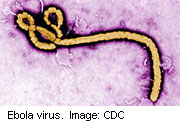Case report describes patient with anterior uveitis and ocular hypertension, with viable EBOV RNA
FRIDAY, May 8, 2015 (HealthDay News) — Recovery from Ebola virus disease (EVD) can be complicated by acute anterior uveitis, with persistent Zaire ebolavirus (EBOV) within the eye, according to a case report published online May 7 in the New England Journal of Medicine. The research was published to coincide with the annual meeting of the Association for Research in Vision and Ophthalmology, held from May 3 to 7 in Denver.
Jay B. Varkey, M.D., from the Emory University School of Medicine in Atlanta, and colleagues describe a patient who recovered from EVD and was subsequently found to have severe unilateral uveitis during convalescence.
The researchers describe the case of a previously healthy 43-year-old male physician who received a diagnosis of EVD while working in Sierra Leone. Ten weeks after EVD symptom onset, many of the patient’s symptoms had improved, but new symptoms had developed, including ophthalmic symptoms. One month later, the patient presented with acute onset of redness, blurred vision, pain, and photophobia in the left eye. The left intraocular pressure was elevated at 44 mm Hg, and the patient was diagnosed with anterior uveitis and ocular hypertension. The symptoms worsened and the aqueous humor tested positive for viable EBOV RNA. The patient’s condition improved with treatment, and follow-up ophthalmic evaluations are ongoing.
“This case highlights an important complication of EVD with major implications for both individual and public health that are immediately relevant to the ongoing West African outbreak,” the authors write.
Copyright © 2015 HealthDay. All rights reserved.








